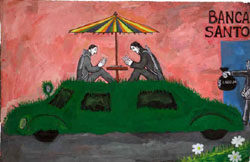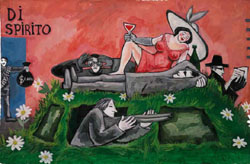|
Sacred architecture |
|
|
Flying Church Making a house for God is an invention of men. Does the Spirit for whom the Milky Way is just an insignificant embroidery on its sleeves really need a little box with a roof, no matter how beautifully decorated? The "place" for worship, and the kind of rituals performed inside it are men's attempts to give shape to their feelings, to make them visible to other human beings, to participate in group adoration. The churches of our happy revolution find inspiration in the visible sources of eternity's movements: the dynamic, ever-expanding starry sky, the never-ending waves of the sea. This revolution's sacred architecture rises from mobile platforms: surfing and windsurfing, sky-boarding, sailing on water and in the air on swift boards and deltaplanes. A church soars literally in the sky, not just pointing to it--a confluence of true "sky pilots" actually guiding deltaplanes, fearless priests, graduates of a seminary where they've learned humility by challenging the stormy sky-seas in solitude, or practiced ocean meditation among dolphins, sea horses and turtles. My clergy take philosophy courses on the edges of deep precipices and waterfalls, argue theology among tall pines and cedars, or riding white water on holy rafts. While darting through clouds, they teach people to express their feelings towards the unknown God joyfully. Some fly, embracing the sail-wing portraits of their patron saints. Confessions are held in sailplanes for two, tandem wings rented for the occasion. Jews and Muslims join together, fighting the air currents instead of each other, creating aerobatic crescent contrails and Stars of David. |
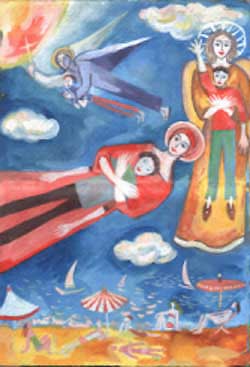 |
|
A lighthouse church On the beach sits a huge tent, sewn from old sailors' pants and shirts. Its silhouette resembles a woman, and the halo around this madonna's head, produced by votive candles, serves as a beacon for mariners on the sea. |
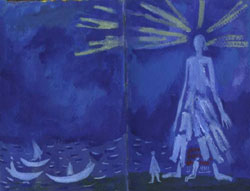 |
|
A church greenhouse Park churches are made by gardener-artists, whose hedge clippers sculpture branches into statues, arches, green pavements decorated with flower mosaics, offering hospitality to animals, insects and birds that join in the praise, buzzing, chirping, growling along with human singers. |
|
|
A fire church We've put screw tops, like so many nuclear cooling towers, on top of volcanoes, transforming their energy to create visions of saints and sacred scenes that burst in the sky as fireworks. |
|
|
Secular architecture | |
|
An ephemeral hotel Three storeys by the river, built of metal tubes painted blue to merge with the color of the water, form a frame. Over them, fishing nets are draped to dry, creating semi-transparent walls for the guests' rooms. By lifting the net walls, visitors can enjoy the 360-degree view of the landscape, seeing everything and seen by everyone. When the walls are down, the nets tremble in the wind making a fan, a gigantic but subtle air conditioner. In the dark, the shadows of the guests moving around inside dance on the walls, projecting capricious designs. The smell of seaweed fills the air. In the deepest night, the nets catch deep-water dreams. And at season's end, the magic hotel is disassembled, leaving only unspoiled beach until the next summer. |
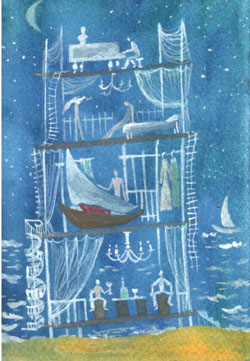 |
| The floating Museum In summer, when the sea is calm and light is diffused (a few hours before sunset), old wooden boats are covered with gangplank tables on which are mounted stands with art work. Visitors, ferried to this museum on sailboats crewed by aged sailors, jump from one table to another one. If they fall in the sea, no worry, they just enjoy a little swim in the warm water before continuing their tour of the exhibition. At sunset, they're ferried back to the river bank, while the museum sails away in different directions. 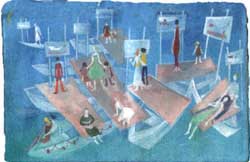 |
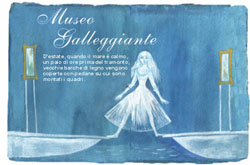 |
|
Scaffold Youth Hostels Among the monuments of tourist cities, facades are festooned with scaffolds, criss-crossed with planks for restoration workers to stand on. The double width of the wooden decks do double duty as hostel floors and ceilings. Inside the hollow metal scafolding runs drinking water and drains. At night, folding beds are set up for tourists, who are happy to fall asleep and wake up so near the antique monuments they've come so far to see. Restorations are subsidized by the profits from renting the hostels. |
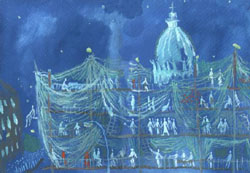 |
|
A wandering charbroil eatery A carnival fire eater moonlights as a cook, barbequing meat and fish with his burning breath. Instead of lighter fluid, he spits out clouds of finely ground bread crumbs which he lights with a match, creating instant toast for breading--a spectacular way of cooking: His tongues of fire lick the meat until it is well done, proving some tongues can be used both for tasting and creating flavors. |
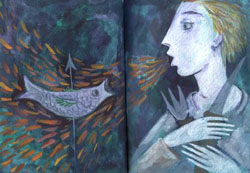 |
| Amusement park offices My revolutionary businessmen meet at the Amusement Park, where everyone finds an office to his taste. Young managers on the make get into a quickly whirling monster-machine which makes them feel the sensations of astronauts preparing for interplanetary flights. While they bob and rotate to the right and left, they take risky financial decisions, with dizzying sums. Such a transfer of offices has helped recharge the stagnant economy. The Stock Exchange has moved too. Now big financial groups play with securities while riding the roller coaster. The rise and fall of the stocks is directly connected to the position of the gondola with "people who count" in it. Managers of companies who practice "slow economy" discuss policy to the gentle up and down motion and waltz music of the merry-go-around. Builders of palaces of commerce decide what to do and where to build while making sand castles in the toddlers' playground. The roads are transparent amber, through which one can see the treasures of past centuries hidden in the earth. The cobblestone sidewalks are decorated with little poems, comic phrases and popular sayings. Cities, parking lots, and apartments, don't grow upward or sprawl outward, but return to the past, where ancient walls and crumbling ruins are converted into uniquely new living spaces. Protected by the solicitude of their new inhabitants from the caprices of constantly changing weather, old constructions are restored and re-utilized. 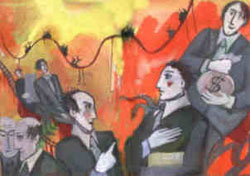 |
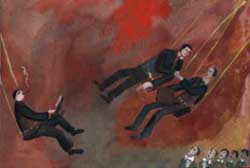 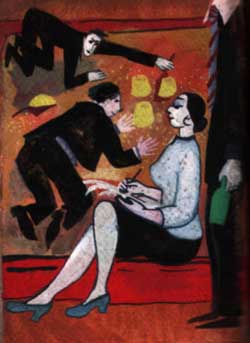 |
| Fashion re-statements |
|
| Dressing up, down and
back A dress is like a bulletin board to be used for communication. It tells the intimate facts of life of a person, publishes her necessities, expresses the desires of the one who wears it. My fashion is to externalize the interior, and invite others to communicate too. Minimalist fashion takes an unexpected turn. As if to contradict decades of unrestrained consumerism, it sees each dress as a second skin. Spaghetti sauce stains, rips, tears and holes are embroidered-over with colorful threads, or repaired with pieces of precious materials. Through this constant renovation, every dress is eternal and every one unique-a genuine original, not a copy off the rack! The more stained and reworked, the more valuable they become. And they never wear out! When writers and intellectuals meet, they sport suits with short stories written on them, and ties with poems. "That haiku looks great on you Mike," they say, or "Yes, for a tall woman like Sarah, only a novel would fit." Some have sad soap opera scripts hidden in their pockets, printed on handkerchiefs for drying the reader's tears. Even lingerie is active, like a changing stage set that shifts to highlight the actors' bodies. The fat lady doesn't need to diet; she wraps herself in layers of ribbons and color, like a gigantic Christmas present for her lover to unwrap on the way to her body. She hides chocolate bars, fruit slices and little champagne bottles here and there to surprise him. When a man's pants drop, fireworks announce what is to come, long-barreled toy canons fire, shooting sparklers at the sky. It's fashionable to wear masks or semi-transparent veils. A woman who wants to change her looks doesn't need plastic surgery; she prints a desired face on the veil she's wearing. To protest against racism, a nordic blond wears a veil with the face of a black woman printed over it. Veils also serve as a bulletin board for the thoughts or deepest beliefs of their wearers. Nuns wear the 10 commandments, Muslims verses from the Holy Koran. Political activists look at the world through protest slogans. Mourning clothes transform the body into a monument in motion: a photo of the deceased is printed on shirt fronts, with phrases for the occasion. Sometimes his story is told--how he lived, how he died. 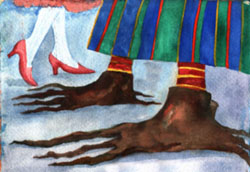 |
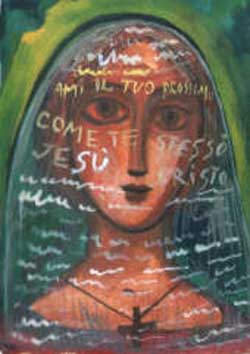 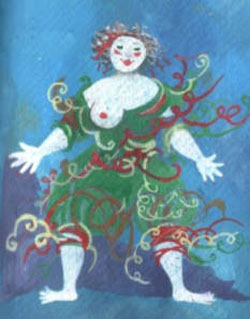 |
|
Everyday life |
|
|
Marine hygiene Between the double walls of the thick glass of the Shower Aquarium, in a forest of seaweeds dart tropical fish. People take showers surrounded by sea life, separated from it only by the glass. From outside, the person showering seems like a shadow, distorted mysteriously by the water behind waving seaweeds. Shower Aquariums are decorative as well as useful. They ornament bedrooms, hotel rooms, even nightclubs and restaurants (especially those that serve seafood), whose owners are happy to install them for clients who arrive for an appointment with friends a bit early, to freshen up after a hard day's work. |
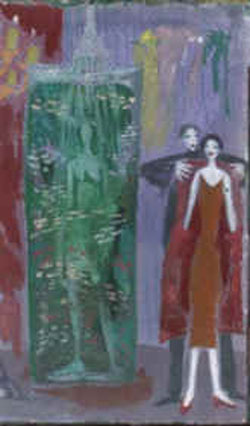 |
| Philosophical dining Sets of Cyclical Plates are appreciated by diners with a philosophical bent. Sealed between two layers of transparent plastic are fish skeletons, onion peels, bread crumbs, even grease stains, so each meal begins with the image of what will remain afterwards. When food is deposited on these plates, diners observe their fish filets hovering above their skeletal futures, pancakes floating above the crumbs they will become. After eating, everyone returns again to the "eternal" images sealed within the plate. For dieters, the process is reversed: they're served a few bread crumbs on plates with whole, untouched pancakes sealed inside. In Boston restaurants, this would recall the traditional Irish delicacy "potatoes and point," where poor families would hang a ham above the table, then serve their children potatoes. Each child would eat a potato, then point at the ham. The spent craters of volcanoes are used as gigantic pots to cook food for the poor. The cones are filled with water, to be heated from the heart of the earth, creating enormous quantities of spaghetti, seasoned with wild herbs that blossom in abundance on the crater walls. Everyone is satisfied without problems. Kindergartens and daycare centers have Railway Cafeterias, where toy trains with boxcars full of food run out on tracks from the kitchen. Kids wait on benches at stations and level crossings for food to arrive, accompanied at each stop by a loud whistle. Children slide the boxcar doors open and take their portions. Zealous geography teachers profit from the lunch break to reinforce their lessons, telling children about trips they've taken to see the world. |
Sea
and sand sleeping Water beds, thick like the old feather mattresses our grandmothers slept on, have fish inside. The oxygen in the water is recycled and refreshed so the fish can breathe. Sleepers have the sensation of being rocked to sleep by waves, to wake up in the middle of the sea. Transparent sheets and pillow cases are printed with old love letters, Harlequin romances, or love poems, so before drifting off sleepers can shed salty-water tears. Since pink moved from the page to the undulating waterbed sheets, there has been a boom in the editing business. The Sand Bed is situated in a huge metal frying pan, heated from below. On cold nights, its warmth rises little by little, filling the room with gentle heat. It provides honeymoon couples with an infinite variety of "seashore" games: they bury one another in the hot sand, build sandcastles of the future homes they'll live in. If they get hungry, they can bake clams on the sand, then fall asleep satisfied, while the shifting mini-dunes massage their backs. After every usage, the sand sheets are sterilized at high temperature inside a ceramic kiln. They never grow old. The more the sand is used, the cleaner it becomes. |
| |
|
|
Automogardens and Plantomobiles
|
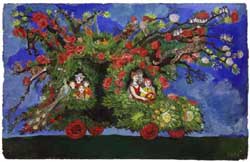 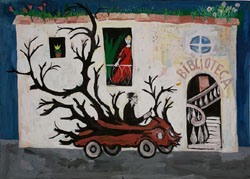 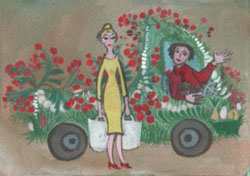 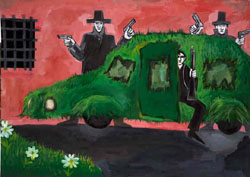
|
|
Scare-orism Even that scourge of life in pre-revolutionary times-terrorism has been transformed by the revolution, into Scare-orism. Freedom from injustice and poverty is won with explosions of hope, not death. Our Scare-orists ambush everyone with sudden gestures of enthusiasm, and flashes of truth. One has learned fire-eating. When a plane takes off, he performs for the passengers, creating a spectacular show that explains his cause graphically, while a Scare-orist clown riding a unicycle up and down the aisle between seats distributes pamphlets. They describe the wonderful destination where the plane ought to go, one where the injustices once suffered by his people have been healed. After their initial shock, the passengers applaud, asking the pilot to divert his course. He's happy to do so, flying nonstop to join the Laughing Revolution |
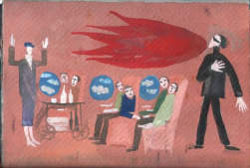 |
